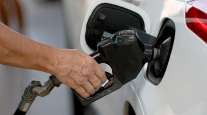Fleets Focus on Driver Performance to Raise Fuel Economy
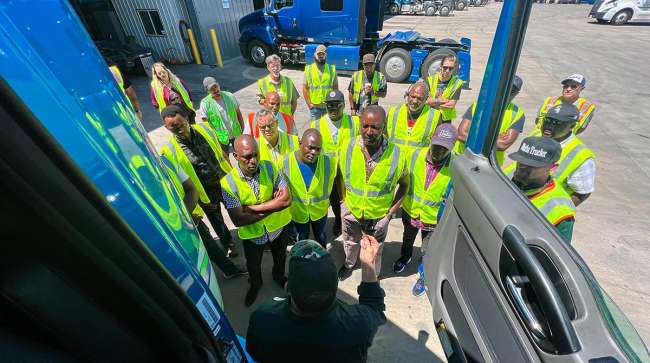
[Stay on top of transportation news: Get TTNews in your inbox.]
A large portion of a fleet’s real-world fuel consumption rests in the hands — and foot — of the person behind the steering wheel, so trucking companies are increasingly investing in training, technology and incentives to optimize driver performance.
Fuel-efficient driving is a priority because fuel is one of carriers’ biggest operating costs, and the way the driver operates the truck accounts for as much as 30% of miles-per-gallon results, according to carriers, driving experts and vendors of in-cab coaching systems.
“The driver has a huge, huge part [in] how much fuel the truck will burn,” said Royal Jones, CEO of Mesilla Valley Transportation.
“In what I would call the perfect truck,” including an electronic governor to limit speed, one driver could get 7 mpg while another driver could get 10 mpg, he added.
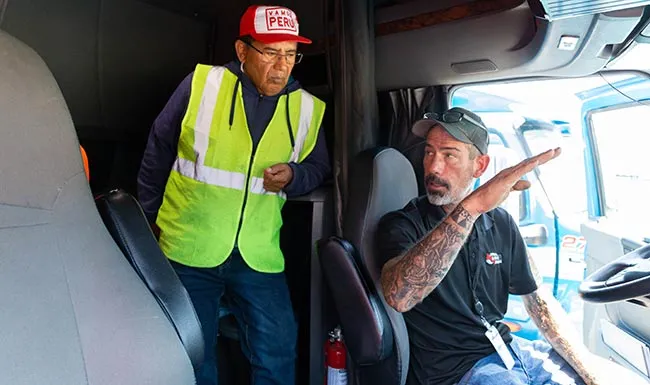
Mesilla Valley Transportation says driver performance can account for 30% of fuel economy results. (Mesilla Valley Transportation)
With the right training and equipment, even new drivers can achieve impressive miles-per-gallon results.
An apprentice driver for Nussbaum Transportation in Hudson, Ill., registered 9.94 mpg during training, said Clark Reed, a driver-instructor who helped teach the apprentice.
“He’s under 21,” Reed said, noting that the newcomer is participating in the Federal Motor Carrier Safety Administration’s registered apprenticeship program that allows training of younger people to operate trucks across state lines.
But how did an apprentice driver achieve 9.94 mpg?
“First, it’s equipment,” Reed said. “You’ve got to have the right equipment to get that done, and Nussbaum’s really good at spec’ing equipment for fuel economy.”
As for driver performance, Reed echoed the same techniques that other driving experts and teachers cite, including going light on the pedal, maintaining safe following distance and, generally, operating the vehicle smoothly.
Dave Schaller, industry engagement director for the North American Council for Freight Efficiency, highlighted the fuel-saving benefits of automated transmissions and adaptive and predictive cruise control. “Nonetheless, the driver’s still a factor,” he said.

Mesilla Valley Transportation CEO Royal Jones (left) with driver trainer Roberto Sandoval. MVT provides a range of rewards and incentives for top performing drivers. (Mesilla Valley Transportation)
To promote fuel-efficient as well as safe driving, some fleets identify their best drivers and make them driver-trainers, as Nussbaum did with Reed and as Mesilla Valley Transportation did with Roberto Sandoval.
In some cases, carriers are augmenting that training with technology, such as telematics systems that help put the spotlight on fuel efficiency.
In-cab devices that provide instantaneous feedback have been on the market for several years. The real-time feedback is crucial, Schaller said, because it reinforces efficient driving practices.
“It’s giving you a chance to learn as you go, and get better,” Schaller said.
Tucker Freight Lines has been using Isaac Coach, an in-cab coaching application provided by Isaac Instruments, since 2019. The Dubuque, Iowa-based carrier runs some 270 tractors and 950 trailers that include dry vans and flatbeds.
Cody McClain, Tucker’s vice president of safety and human resources, said he considers acceleration the most significant opportunity to improve driver performance.
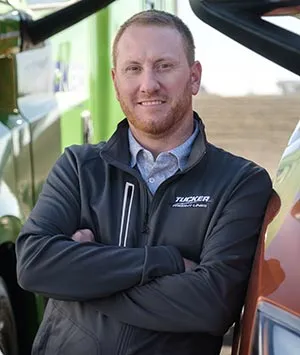
Cody McClain, vice president of safety and human resources at Tucker Freight Lines. (Tucker Freight Lines)
“It’s habit to pin it to the floor to try to get out into a lane [from] an on-ramp,” McClain said.
The system’s feedback coaches drivers to take more time to get up to speed, he said.
It also highlights harsh braking and turning.
“Everyone doesn’t always associate that with fuel economy, but if you’re braking harshly quickly, you’ve got to get back up to speed,” McClain said.
Isaac Coach is designed to score driver performance fairly by “taking out of the equation stuff he doesn’t control,” said Jean-Sebastien Bouchard, co-founder and executive vice president of sales at Isaac Instruments.
“To judge a driver’s fuel efficiency on just the miles per gallon is super hard because he controls just a fraction of it,” Bouchard said. The truck, the load, the terrain and weather all influence mpg.
Isaac Coach displays a color-coded indicator on an in-cab tablet. As the driver applies pressure to the pedal, the display’s feedback tells the driver “just how much pedal he needs to use to counter the resistance that’s around him,” Bouchard said. The resistance can be a heavy load, a buffeting wind, a hill.
The goal for drivers is 95% adherence to the color-coded cues. Users reported up to a 5% gain in fuel efficiency, Bouchard said.
Telematics systems generate valuable information for driver training, trucking executives and vendors said.
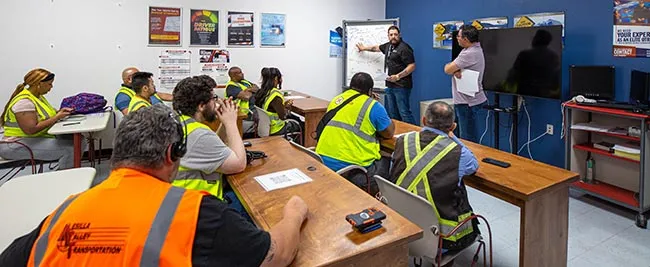
Drivers hear instruction during a training class at Mesilla Valley Transportation. (Mesilla Valley Transportation)
Drivers are busy, so feedback needs to be in a simplified format that’s easy to understand and act on, “whether it’s driving less aggressively or braking less or [something to do with] their cruise control time or idle time,” said Daryl Bear, chief operating officer and lead engineer at MVT Solutions, a Mesilla Valley Transportation subsidiary that provides fuel efficiency consulting.
Many over-the-road fleets have a governor to limit the truck’s top speed on the pedal, while a slightly higher speed is allowed by the cruise control.
“It’s more fuel-efficient than an average driver, but it’s not necessarily more fuel-efficient than a good driver,” Bear said.
Fleets can use data to help them score and coach drivers, he added, “but, of course, that takes time and some expertise to do.”
Telematics provider Platform Science announced in March that Maverick Transportation is implementing its technology.
The truckload carrier is deploying driver-centric apps that Platform Science offers through its fleet management system.
“We have a driver performance scorecard as part of our solution,” said Luke Wachtel, senior vice president of transportation and logistics for Platform Science.
The vendor’s open platform also enables carriers to use their own gamification apps that promote fuel-efficient driving, Wachtel said.
Maverick will be able to expand the use of its Drive Maverick app on the platform.
Trimble last year announced it was integrating its fleet management system with Tenstreet’s True Fuel technology to provide real-time, in-cab audible coaching combined with fuel efficiency data.
Gary Falldin, senior director of industry solutions for Trimble, said mpg “doesn’t tell the whole story” of fuel efficiency.
A better approach is real-time, in-cab coaching, followed by reports that show mpg and a driver’s fuel efficiency, Falldin said.
True Fuel, as an over-the-air add-on to Trimble telematics, enables reporting on the fuel efficiency of the driver, he said.

Peter Voorhoeve, president of Volvo Trucks North America, discusses what it takes to make electric vehicles successful in the trucking industry. Tune in above or by going to RoadSigns.ttnews.com.
The system can discern and, if needed, discount inequities when comparing the fuel efficiency profiles of different equipment operating in different conditions.
A longhaul, over-the-road driver pulling heavy loads with a newer truck with an automated transmission might post 7.5 mpg. Another driver, moving heavy loads in urban settings, operating an older truck with a manual transmission might get 6.4 mpg. The potential mpg of each truck is important in determining the true fuel efficiency of each driver, Falldin said.
The driver getting 6.4 mpg might have equipment with the potential to get 6.5 mpg, which would be a highly fuel-efficient performance. The driver getting 7.5 mpg might have the potential to get 8.2 mpg, a performance that leaves room for improvement.
“You can’t just look at mpg,” Falldin said. “Especially if you’ve got a bonus system for drivers.”
True Fuel provides a “normalized” score of what’s under drivers’ control, accounting for driving and equipment differences, said Tenstreet CEO Tim Crawford.
He added that communicating to drivers why they should engage with in-cab coaching is crucial to achieving fuel-efficiency goals.
“There are so many demands on the driver’s attention,” Crawford said, citing safety, tight schedules and complying with regulations. “Why do they need to spend attention on this one topic?”
The inclusion of a “baked-in” rewards system with True Fuel is designed to ease the administrative burden for carriers as they track and reward drivers’ fuel economy results, Crawford said.
“It’s hard to administer a program,” he said. Tenstreet’s Rewards platform enables fuel-efficient drivers to redeem points for electronics, home goods, movies and tools.
Although reducing speed is one of the best ways to improve fuel mileage, that also results in fewer miles and therefore less pay for drivers who are paid by the mile, Mesilla Valley’s Jones said.
To make driving slower more appealing, Mesilla Valley gives $25,000 to the driver or team with the best mpg each year, Jones said. The driver or team must have had no accidents and must also meet a total mileage for the year.
Each quarter, the company gives away a new car. “But you can only win the car once,” Jones said.
To further engage drivers, Jones said, the company awards monthly per-mile bonuses to those who beat the fleet’s average mpg. The bonuses start at one penny per mile and max out at 4 cents per mile, and are based on how much a driver’s mpg exceeds the fleet average.
Mesilla Valley Transportation has been offering incentives for about 10 years, Jones said. He estimated that the company has given away 30 motorcycles and 42 cars.
Incentives work, and “they keep people trying,” Jones said.
Bear said that if a driver achieves a specified level of fuel economy, Mesilla Valley Transportation “allows the truck to go faster, which sounds counterintuitive, but [the opportunity] to go faster is an incentive for the driver because they can do more miles,” Bear said. “But we don’t see a lot of fleets doing that. It takes a lot to manage it.”
MVT, based in Las Cruces, N.M., ranks No. 73 on the Transport Topics Top 100 list of the largest for-hire carriers in North America.
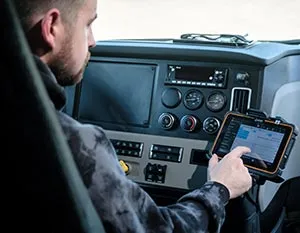
A Tucker Freight Lines driver uses an Isaac device to input hours-of-service data. The fleet also uses the Isaac Coach app to boost driver performance. (Tucker Freight Lines)
Tucker Freight Lines is putting the finishing touches on an incentive program based on drivers’ Isaac Coach scores, McClain said. “If we see the value in them having the higher score, we want to incentivize them to get more pay.”
Focusing on fuel efficiency yields additional benefits, including enhanced safety and reduction in costs, carriers and others said.
“When you’re getting better fuel mileage, you’re not working the motor as hard,” Mesilla Valley’s Jones observed. “When a guy drives smooth and easy to get fuel mileage, he or she also wrecks less, the tires last longer, the brakes last longer, the whole truck lasts longer. I always tell people, ‘If you drive a truck like it’s about to break, it never will.’ ”
Want more news? Listen to today's daily briefing below or go here for more info:




